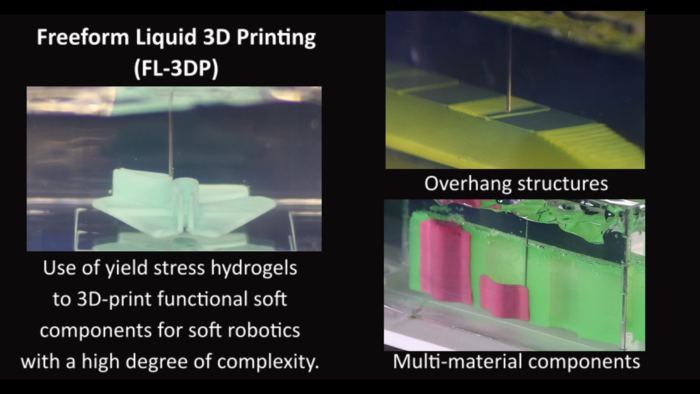Reviewed by Alex SmithApr 8 2022
At the Singapore University of Technology and Design (SUTD) a method adopting the Freeform Liquid 3D Printing (FL-3DP) technology has been developed to 3D print more strongly and geometrically complex components for soft robotics.
 Use of yield stress hydrogels to 3D-print functional soft components for soft robotics with a high degree of complexity. Image Credit: Singapore University of Technology and Design.
Use of yield stress hydrogels to 3D-print functional soft components for soft robotics with a high degree of complexity. Image Credit: Singapore University of Technology and Design.
FL-3DP is a budding technology exhibiting high potential enabling the 3D printing of multi-material functional components. It makes use of gel as a temporary suspension media in which inks are ejected and held in position. As soon as the inks are solidified, then the gel can be washed off easily.
This method overcomes two significant limitations experienced in present 3D printing technologies. First of all, it allows the 3D printing of materials that take a prolonged time to solidify while being extruded.
Secondly, as a result of its potential to hold inks and retain them in the liquid state, advanced geometries like overhanging structures shapes with high-aspect ratios, or fine combinations of multiple materials, have become a possible option.
But early FL-3DP was identified to have limited features while fabricating sophisticated components as only mono-material structures or simple shapes like shells and meshes could be illustrated.
The lack of more complicated demonstrators despite the promises of this technology could be partly described by issues associated with regulating the interfaces between the inks and supports, thereby demanding the printing resolution.
The scientists of SUTD managed to better anticipate the filament shape, which resulted in enhanced printing resolution and fidelity over an in-depth study of the rheological properties and interfacial stabilities between support gels and inks.
This result allowed the complete exploitation of FL-3DP technology, via the fabrication of complicated elastomeric-based components integrating multiple materials and the improvement of the range in hard geometrical prints.
The study has been reported in the ACS Applied Materials & Interfaces journal.
Sophisticated pneumatic components for soft robotics applications that are typically used in soft grippers were developed and fabricated by the researchers. This was done to illustrate the benefits of FL-3DP over traditional manufacturing methods like molding and casting.
Through the integration of soft, hard and functional elastomers, the researchers were able to accurately control the shape deformation of the components, tune their functionalities by fixing the friction of soft gripper surfaces or by offering sensing capabilities, and improve the lifespan of components by up to ten times than their conventional cast counterparts.
These results obtained are known to be a part of a global effort to mark a new era for extrusion-based 3D printing with the help of suitable suspension media. Also, this improved method provides a wider design space for designers and engineers and could profit several applications.
This includes soft robotics where strong and complicated combinations of an extensive range of materials and functionalities are needed.
At present, the team is working on broadening the range of processable materials by coming up with a new suspension media which seems to be chemically compatible with more inks.
FL-3DP and other new extrusion-based additive manufacturing processes are getting us closer and closer to the ultimate target goal of full direct co-fabrication of complex functional systems such as robots and other complex functional products and devices.
Pablo Valdivia y Alvarado, Study Principal Investigator and Assistant Professor, Singapore University of Technology and Design
Journal Reference:
Calais, T., et al. (2022) Freeform Liquid 3D Printing of Soft Functional Components for Soft Robotics. ACS Applied Materials Interfaces. doi.org/10.1021/acsami.1c20209.